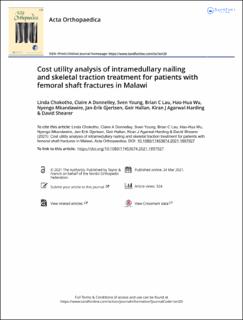| dc.description.abstract | Background and purpose — In Malawi, both skeletal traction (ST) and intramedullary nailing (IMN) are used in the treatment of femoral shaft fractures, ST being the mainstay treatment. Previous studies have found that IMN has improved outcomes and is less expensive than ST. However, no cost-effectiveness analyses have yet compared IMN and ST in Malawi. We report the results of a cost-utility analysis (CUA) comparing treatment using either IMN or ST.
Patients and methods — This was an economic evaluation study, where a CUA was done using a decision-tree model from the government healthcare payer and societal perspectives with an 1-year time horizon. We obtained EQ-5D-3L utility scores and probabilities from a prospective observational study assessing quality of life and function in 187 adult patients with femoral shaft fractures treated with either IMN or ST. The patients were followed up at 6 weeks, and 3, 6, and 12 months post-injury. Quality adjusted life years (QALYs) were calculated from utility scores using the area under the curve method. Direct treatment costs were obtained from a prospective micro costing study. Indirect costs included patient lost productivity, patient transportation, meals, and childcare costs associated with hospital stay and follow-up visits. Multiple sensitivity analyses assessed model uncertainty.
Results — Total treatment costs were higher for ST ($1,349) compared with IMN ($1,122). QALYs were lower for ST than IMN, 0.71 (95% confidence interval [CI] 0.66–0.76) and 0.77 (CI 0.71–0.82) respectively. Based on lower cost and higher utility, IMN was the dominant strategy. IMN remained dominant in 94% of simulations. IMN would be less cost-effective than ST at a total procedure cost exceeding $880 from the payer’s perspective, or $1,035 from the societal perspective.
Interpretation — IMN was cost saving and more effective than ST in the treatment of adult femoral shaft fractures in Malawi, and may be an efficient use of limited healthcare resources. | en_US |

